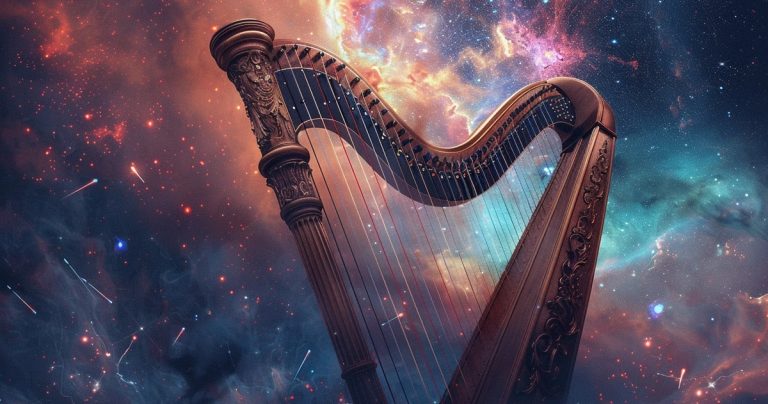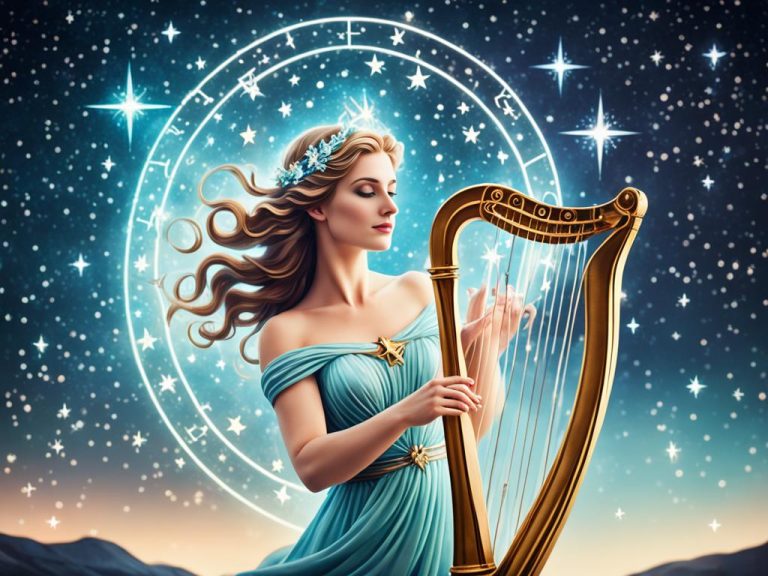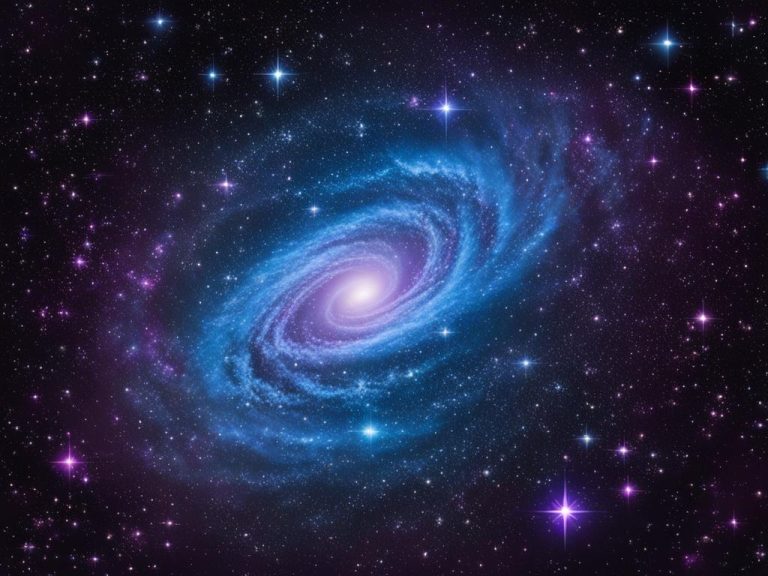Explore the Wonders of Lyra Constellation
Modified: July 1, 2024 Author: International Star Registry
Did you know that Lyra is a beautiful constellation seen in the Summer sky of the Northern Hemisphere? It shows stunning deep-sky objects and notable double stars. Positioned between Cygnus and Hercules, it’s a top pick for anyone interested in stargazing.
Lyra gets its name from a harp-like musical instrument. This association hails from ancient Greek times and legends, connecting Lyra to the famous musician Orpheus. Yes, “lyre” is what Lyra means in the Greek language.
The star Vega shines as a standout feature in Lyra. It’s part of the Summer Triangle, alongside Deneb in Cygnus and Altair in Aquila. Vega is not your average star; it twinkles with a special brightness and is very meaningful to astronomers.

Key Takeaways:
- Lyra is a well-known constellation in the Northern Hemisphere’s Summer sky.
- It is named after a small stringed instrument shaped like a harp.
- Lyra is associated with the Greek musician Orpheus and holds mythological significance.
- The constellation contains deep-sky objects and notable double stars.
- Bright star Vega is part of the Summer Triangle and has astronomical significance.
The Bright Star Vega and the Double-Double
In the Lyra constellation, two stars are very bright – Vega and Epsilon Lyrae, the Double-Double. Let’s learn about these stars and what makes them special.
Vega, called the Harp Star, is the fifth brightest star that you can see. Known as the main star in the Summer Triangle, it’s just 25 light-years away. Vega shines with a blue-white light in the sky. With a magnitude of +0.03, it’s easy to see, especially if you live in the north.
Vega is quite hot, at nearly 17,000 degrees Fahrenheit. It’s bigger than our sun and twice as heavy. This star spins quickly, making it look flat. It takes around 12.5 hours to spin once.
Our solar system and the one around Vega are alike. Both have a zone close to the star and another farther out. There is a space between them. This shows how planets might form.
Vega will not last forever. Despite its brightness, it will burn out in about 500 million years. Then, it will change into a white dwarf star.
Now, look at Epsilon Lyrae, known as the Double-Double. It’s actually five stars close together. Yet, they look like one from Earth. Epsilon Lyrae is much farther than Vega, about 162 light-years away. It appears dimmer in the sky, with a magnitude of +4.7.
Using binoculars or a telescope, you can see that Epsilon Lyrae is four stars. Epsilon 1 and Epsilon 2 are each thousands of times farther from us than the sun. They are about twice the size of our sun. A third star, Epsilon 1B, is a bit cooler and lighter.
The stars in Epsilon Lyrae move in different ways. Epsilon 1A and Epsilon 1B circle each other every 1,800 years. Epsilon 2’s stars need about 724 years for one orbit.
There’s still mystery around the fifth star in this system.
Explore the beauty of the Lyra constellation with these amazing stars. For more on Epsilon Lyrae and Vega, check out:
- Epsilon Lyrae: The Famous Double-Double Star
- Vega: Brilliant Blue-White Star
- Lyra Constellation: A Comprehensive Guide
Discover the magic of Lyra, where Vega and Epsilon Lyrae await.
Deep-Sky Targets in Lyra
Lyra is a special place with lots of amazing things to see in the sky. One famous object here is the Ring Nebula, or Messier 57. It looks like a ring and is bright with a magnitude of +8.8. Interested in learning more about the Ring Nebula in Lyra? Click here.
Messier 56 is another cool thing to see, known as a globular cluster of stars. Charles Messier found it first. It shines with a magnitude of +8.3 and is about 33,000 light-years from us. To find out more about Messier 56, visit this guide here.
Lyra also has galaxies and star groups. NGC 6703 and NGC 6702 are two galaxies to look at. NGC 6743 is a cluster with 35 stars, and NGC 6791 is an older cluster with about 380 stars. These places show the beauty of Lyra’s sky in an exciting way.
Looking at these wonders is great for everyone who loves the sky. You may enjoy seeing globular clusters, nebulas, or galaxies in Lyra. For more info on these objects, visit this guide here.
The Mythological Significance of the Lyra Constellation
Lyra is known as the celestial harp in Greek mythology. It tells of Orpheus, a great lyre player. He made a special lyre that could touch even the gods’ hearts.
Orpheus’s music was powerful. It could make anyone feel deep emotions. He went to the underworld to save his wife, Eurydice, with his music.
Orpheus played so well that even Hades was moved. His music reached all in the underworld. But, his mission ended sadly.
Still, his story showed how music, poetry, and art can change things. The constellation Lyra is a sign of this power. It’s about love and the balance in the world.
Lyra’s story has been told in many places. It shows the value of creativity and beauty. Even now, Lyra inspires people in many ways. It makes us think about the big stories in the sky.

The tale of Lyra connects us to the stars. It makes us see how old stories meet with the beauty above us. This makes Lyra even more amazing to us.
The Modern Significance of Lyra
Today, Lyra wows both experts and casual star watchers. Its rich history, many stars, and fascinating objects make it a key part of astronomy.
Vega, the most notable star in Lyra, is very bright. As the fifth brightest star, it shines in the sky with a magnitude of 0.03. It stands out, even in cities with lots of lights.
In Lyra, you can see 73 stars that shine brighter than 6.5 magnitude. It’s truly a starry experience. Plus, you can spot amazing sights like the Ring Nebula and Messier 56. For best views, aim for dark locations with little light pollution.
Lyra’s importance goes beyond its stars and objects. It has strong ties to stories from Greek mythology. The constellation represents the lyre of Orpheus, a famous musician, adding a magical touch.
To find out more about Lyra, its history, and its top stars, check out these resources:
- Wikipedia: Get in-depth info on Lyra’s fascinating history and features.
- Unistellar: Explore unique insights and observations about Lyra.
- Britannica Kids: Dive into educational content about Lyra made for young astronomy lovers.
Lyra stands out today for its beauty and stories. It’s still a favorite for anyone who loves looking at the stars.
Continue exploring Lyra and its wonders:
- Learn about the Summer Triangle star pattern, including Vega, along with Altair and Deneb.
- Discover the small triangle from Epsilon and Zeta Lyrae, seeing Zeta as a wide binary star with binoculars.
- Marvel at Delta Lyrae, a special optical double star where two stars line up beautifully.
Lyra’s drawing power for the curious and the star lovers continues to grow. It’s an endless source of inspiration.
Name a Star in Lyra with International Star Registry
Want a unique gift? How about naming a star after a loved one? With International Star Registry, you can give them a part of the sky.
They have many star packages in the constellation Lyra. Lyra is known for its beauty. It makes a great gift for birthdays or anniversaries.
Your star’s name gets recorded officially. You get a certificate and the star’s exact spot. You can always find it in the sky.
You can make the star’s name special. Personalize it for your loved one. Add a message to make it unforgettable.
International Star Registry has been doing this for over 45 years. They are the best at what they do. Join the millions who have named a star.
Naming a star makes a special gift. Give a memory that lasts forever. Visit International Star Registry to get started today.
The Celebrities of Lyra
Many famous people have stars in the Lyra constellation named after them. This includes musicians, actors, and actresses. Lyra is a special place in the sky for entertainment stars.

Stars in Lyra include those named after well-known people like Harry Styles and Audrey Hepburn. Their stars light up the sky, just as they did our lives. Other celebrities with stars include Harry Styles, Sidney Poitier, Elvis Presley, Johnny Cash, Debra Hill, Marilu Henner, Audrey Hepburn, John Brown, Kelly Lynch, and Marvin Hamlisch.
Naming a star in Lyra after someone special adds honor and exclusivity. This unique gift is a way to show love for celebrities or important people in your life. Can you imagine looking up at the night sky and seeing a star named after someone you love or admire? It’s a connection that feels both beautiful and timeless.
Observing Lyra and Tips for Stargazers
Observing Lyra lets you wonder at the night sky’s beauty. Prepare well for your stargazing trip to really enjoy it.
Use a star chart or an astronomy app to find Lyra. They show you where it is in your sky. Pick the type you like, digital or paper, to help you see better.
For the best view of Lyra, go somewhere without many lights. Look for a dark, rural spot. This way, you can enjoy all of Lyra’s stars clearly.
Think about getting binoculars or a telescope. They make seeing Lyra’s stars and objects much clearer. A good telescope can show you even more.
Pick clear, cloudless nights to see Lyra well. Always check the weather before you go out. This helps you get the best view of Lyra.
Observing Lyra can teach you a lot. Enjoy the constellation’s beauty and wonder at its stars. Have a great time stargazing!
Unlocking the Cosmic Allure of Lyra
Lyra is a beautiful and inspiring sight in the night sky. It looks like a harp or lyre, which brings a feeling of magic. This connection to old stories and our love for the stars makes Lyra special.
The bright star Vega shines from the top of the lyre. It lights up the night, drawing us closer to wonder with its beauty. Staring at Vega can spark our curiosity about the universe.
Lyra gets its name from a harp-like instrument played by the Greek musician Orpheus. His music was so moving that it touched both gods and people. This shows the deep link between music and the spiritual world.
Lyra has inspired many musicians and artists over time. Its beauty and meaning continue to capture our hearts today. Looking at Lyra, we’re encouraged to let our creativity soar and find inspiration in the vastness of space.
International Star Registry lets you name a star after someone in the Lyra constellation. This is a great way to remember a special moment or honor someone you love. It’s a unique gift for birthdays, graduations, or other important times.
International Star Registry: Preserving Memories Through Star Naming
Since 1979, International Star Registry has been the place to name stars. They keep a record of the star names in their own star catalog. This gives people a connection to the stars that lasts a lifetime.
Naming a star is simple and special with International Star Registry. Choose Lyra, and you’ll get a custom package. It includes a certificate with your star’s name, a map showing where it is, and more info about space.
Naming a star in Lyra is a great way to honor someone or mark a special event. It’s a gesture that shows your care and appreciation for the universe’s beauty. This special gift will be a reminder of the endless wonders of space.
Conclusion
Lyra is truly wonderful, blending myth and science beautifully. It shows the bright Vega and more, inviting all to explore the sky’s mysteries.
It’s more than just a pretty sight. Lyra’s stories take us back in time, showing how people have loved the stars for ages. With International Star Registry, we can buy a star for someone, making a unique gift.
For anyone into stars, Lyra is full of chances to see and learn new things. So, start your journey under its gleaming stars today.
FAQ
What is Lyra constellation?
Lyra is found in the Summer sky in the Northern Hemisphere. It is between Cygnus and Hercules. You can spot it easily because it looks like a parallelogram.
How did Lyra get its name?
Lyra is named after the harp, a small harp-shaped instrument played in ancient Greece. It is linked to the musician Orpheus. Lyra is one of the 48 constellations named by the Greek astronomer Ptolemy.
What are some notable celestial objects in Lyra?
Lyra has bright stars and special deep-sky objects. Its brightest star is Vega, the Harp Star, found in the Summer Triangle. Another interesting object is Epsilon Lyrae. It’s a system of four stars known as the Double-Double. You can see it with binoculars or a telescope.
What are some deep-sky targets in Lyra?
Lyra has many deep-sky objects. For example, there’s Messier 57, called the Ring Nebula, and Messier 56, a globular cluster. These are well-loved by astronomers for their beauty in the night sky.
What is the mythological significance of Lyra?
Lyra is linked to Orpheus, the legendary musician in Greek mythology. His music was so beautiful that even the gods cried. Lyra’s connection to music and art makes it a symbol of creativity and beauty in different cultures.
What is the modern significance of Lyra?
You can easily find Lyra in the night sky, even under city lights, because of Vega’s brightness. It holds a lot of celestial wonders, and its rich history and stories make it interesting for astronomers, both amateurs and professionals.
How can I name a star in Lyra?
To name a star in Lyra, get a star naming pack from International Star Registry. Pick Lyra, name your star, and write a message. Your star will be kept in their records, making it a special part of the night sky.
Which celebrities have stars named after them in Lyra?
Lyra’s named stars include Harry Styles, John Brown, Kelly Lynch, Sidney Poitier, Elvis Presley, Audrey Hepburn, and Johnny Cash. This honors your loved one uniquely or someone special with a star in Lyra.
How can I observe Lyra and its celestial objects?
Use an astronomy app or a star chart to find Lyra’s location above you. Go to a dark spot away from city lights. With binoculars or a telescope, you can see Lyra’s stars and deep-sky objects clearly.
What is the cosmic allure of Lyra?
Lyra’s shape is like a musical instrument, adding to its beauty. Its stories from history and mythology are part of its charm. They connect us to ancient times and our love of the stars.
Source Links
- Summer Constellation Spotlight: Lyra | Celestron – https://www.celestron.com/blogs/knowledgebase/summer-constellation-spotlight-lyra
- Lyra – The Lyre – Our Universe for kids – https://www.ouruniverseforkids.com/lyra-the-lyre/
